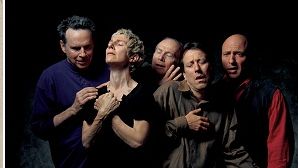
Press release -
Passions opens at Nationalmuseum on 8 March
This spring’s big exhibition, Passions, opens on 8 March, and explores how artists have depicted various emotions over the centuries, from the Renaissance to the present day. The artists represented include such names as Dürer, Munch, Rembrandt, Tony Oursler, Rineke Dijkstra and Bill Viola.
Emotions affect us all, and the need to understand, communicate and make sense of emotions is therefore strong. But it can be hard to interpret our own emotions and those of others, and emotions have been seen very differently through the ages. Emotions have been depicted in Western art since antiquity. Passions – Five Centuries of Art and the Emotions thus concentrates on how artists have interpreted and portrayed emotions such as joy, sorrow, suffering and melancholy through facial expressions, gestures and body language from the time of the Renaissance to the present day. The exhibition also draws several interesting parallels between the ways that art, science, theatre and music deal with our emotions.
Over the years, there have been all sorts of different ideals regarding emotions. Portraiture of the 16th century often depicts self-control and a stoical calmness. The portraits offer us sombre, distanced poses, with serious, concentrated facial expressions concealing all emotions. Older religious material, on the other hand, provides a rich seam of dramatic depictions of sorrow and suffering. Common subjects are the dead Christ and the deeply grieving Virgin Mary, or an anguished Mary Magdalen repenting her sinful life.
In 17th-century France, Charles Le Brun, painter to the Court of King Louis XIV, created a large number of generalised images, or ‘templates’, showing how various emotions should be depicted. They provided a kind of guide for painters struggling to portray dramatised emotions. His Caractères des passions were then engraved by Sébastien Le Clerc and proved extremely popular, with artists making keen use of them right into the early 19th century as far afield as Sweden.
Through the emergence of psychoanalysis via Sigmund Freud, the late 19th and early 20th centuries saw an explosion of interest in the human subconscious. This filtered through into art, with subjective mental emotions often depicted using colour and shape. One of those who delved deep into the emotions and subconscious from a psychological perspective was Norwegian artist Edvard Munch, and the exhibition contains his work Despair plus a lithograph of The Scream.
The exhibition also includes six works by contemporary artist Bill Viola to bring the theme right into the present. Viola concentrates on depicting emotions in a series of video installations, such as The Quintet of the Astonished, which presents five people who are overcome with strong emotions, conveyed in extreme slow-motion. From a neutral state, the expressions of emotion change and build slowly towards a climax that will leave each person totally drained.
One part of the exhibition considers the quasi-science of physiognomy and its theory that it is possible to read and interpret a person’s inner qualities via their external appearance. A range of key works from the field of physiognomy have been loaned from the Hagströmer Library at Karolinska Institutet. In the early 20th century, it was also common to study the different facial expressions of people under hypnosis, as shown in a range of paintings, photographs and book illustrations. Also in the exhibition is a research station called the Emotion Lab, which is on loan from the Department of Clinical Neuroscience at Karolinska Institutet. In theatre too, a great deal of emphasis has been placed on facial expressions, gestures and body language, and numerous handbooks have been published, using words and images to explain how an actor should convey different emotions on stage. The exhibition therefore presents a number of theatre books loaned from the Music and Theatre Library of Sweden.
On display are almost 200 works from the Renaissance to the present day, either from Nationalmuseum’s collection or on loan. The works include paintings, sculptures, video installations, drawings and graphics by artists such as Dürer, Munch, Rembrandt, Tony Oursler, Rineke Dijkstra and Bill Viola. As part of the exhibition’s experimental staging, the gallery will feature mirrors that allow visitors to take in both the works on display and their own emotional reactions, as well as those of others.
The exhibition will run from 8 April to 12 August 2012.
Catalogue
The exhibition is accompanied by a fully illustrated exhibition catalogue containing articles written by specialists in various areas. The contributors include Karin Sidén and Martin Olin from Nationalmuseum, Arne Öhman from Karolinska Institutet, Karin Johannisson, intellectual historian, Lena Johannesson, art historian, Lars Berglund, musicologist, Jonas Liljequist, historian and Sven-Olov Wallenstein, philosopher. Contact the press officer for review copies of the catalogue.
Special thanks to The Barbro Osher Pro Suecia Foundation and to Sven Hagströmer for generous financial contribution to the exhibition and the catalogue.
Further information
Karin Sidén, exhibition curator, karin.siden@nationalmuseum.se,
+46 8 545 837 01, +46 768 91 86 88
Hanna Tottmar, press officer, hanna.tottmar@nationalmuseum.se,
+46 8 5195 4390, +46 767 23 46 32
Press images
www.nationalmuseum.se/pressroom
Captions
Rembrandt, Self-portrait, Nationalmuseum; Bill Viola, The Quintet of the Astonished, © Bill Viola
Categories

